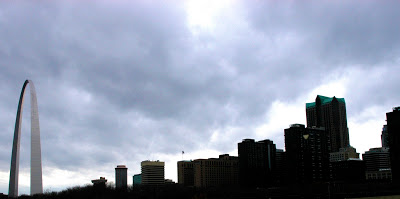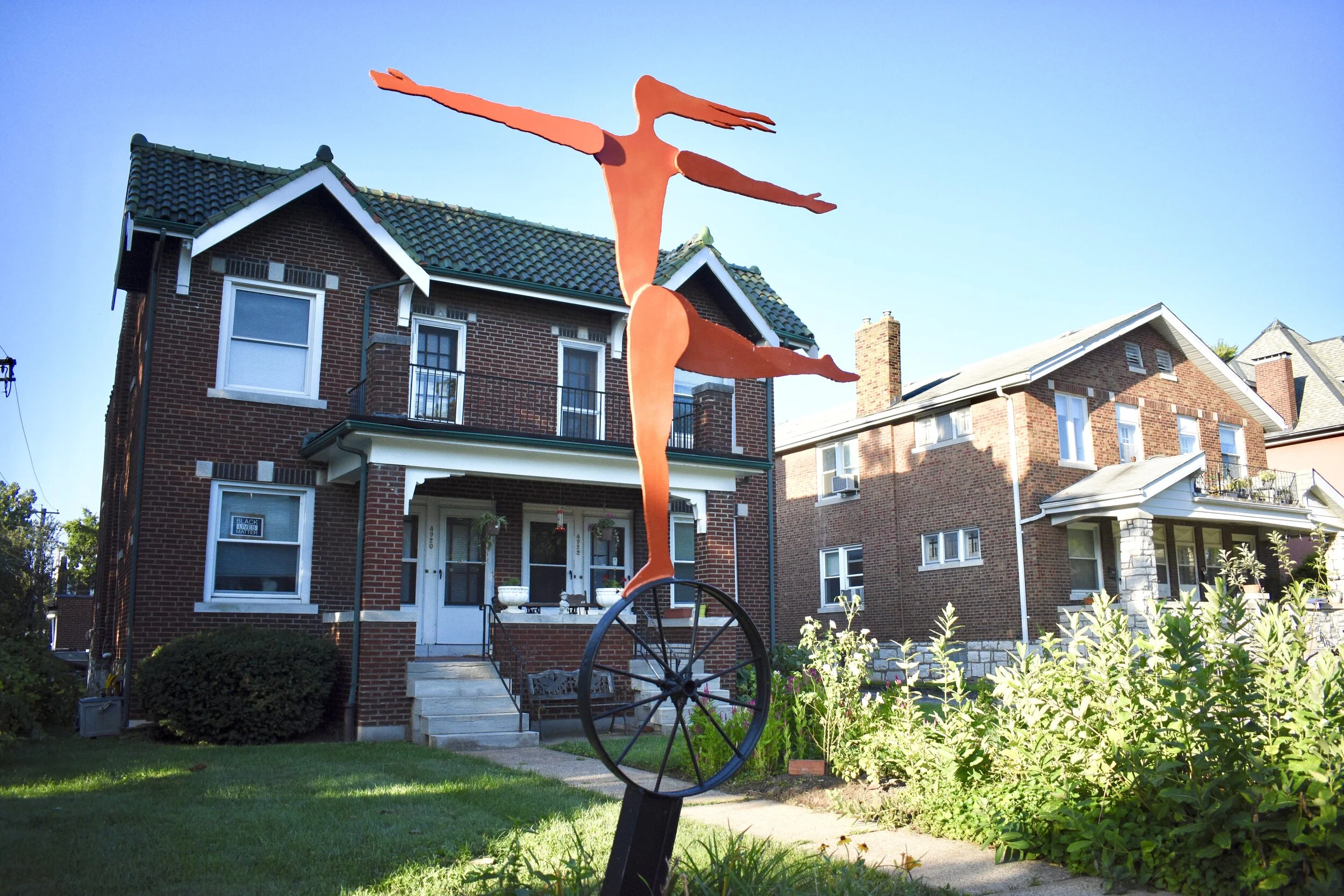I am a big fan of the locally produced show "Donnybrook" on public television station KETC Channel 9.

Per the
:
The show that gives new meaning to the word “debate.”
Thursdays at 7:00 p.m., Followed by Donnybrook…Your Turn at 7:30 p.m.
don-ny-brook (don’e-brook), n. [slang], a rough, rowdy fight or free-for-all
See what happens when five quick-witted, highly opinionated St. Louis journalists disagree on tough topics. This is not another dry, tame talk show. On Donnybrook, the issues are hot and so is the discussion. It’s a high-energy, no-holds-barred debate on the week’s news topics. With tongue-in-cheek, Donnybrook’s subtitle is “polite conversation on the issues.” With host Charlie Brennan, the conversation is highly opinionated and not always “polite.” The panel of regulars tackles tough issues and controversial subjects. The opinions are well-informed and widely divergent.
I like that they are discussing local issues and try to maintain a broad range of opinionated panelists. It can be very entertaining.
But, after tuning in (off and on) for several years now, I can't help but think it would be fun to expand on the local show and have a sort of Donnybrook-II...The Next Generation. One with even more emphasis based on St. Louis issues as opposed to the more regional or statewide topics. An urban-progressive donnybrook so to speak. I take from the next generation...Generation Y.
I believe the current panelists are all Baby Boomers. And while I appreciate their perspectives, I think the next generation in their 20s and 30s (ones who want to live in a vibrant city) are the keys to St. Louis' future. They will be the ones that move back in large enough numbers to maybe, just maybe, bring us to our first population gain in over 60 years. I hear many of the baby boomers in St. Louis talking about why something
won't
work in St. Louis, and constantly pointing to events of the past 50 years in STL as to why something will fail now. Now I get it, you have to look to the past to understand the future. But you've got to admit, we've had among the worst 50 years in the history of any American city. We've been beaten, battered and left as broken. I don't blame the boomers, they've seen St. Louis get worse and worse, decade after decade. We've had failure of leadership and massive population decreases and a beautifully crafted urban city destroyed and abandoned...all in 50 years or less.
But, maybe St. Louis is on the mend. Maybe the more optimistic generation Y'ers will be able to pick up the pieces, forget the worst years in our history and be more prone to look forward more often than not to create a city they want to live in, not the one the boomers watched go to pot during their lifetime.
Back to the current Donnybrook panelists; do they represent current thought patterns in St. Louis? Do they even live and have the right to vote in the city? Based on the bios below, at least one (Wendy Wiese) does not:
Charlie Brennan
Charles Brennan is in charge of radio station KMOX’s top-rated weekday mid-mornings. Brennan has been voted St. Louis’ favorite talk show host four times in the Readers Polls of the Riverfront Times. In 1998, he was named Media Person of the Year by the St. Louis Press Club. Brennan was named one of America’s top 25 “most influential radio talk show hosts” in USA Today. Brennan has worked at KMOX since 1988, after working in Boston radio beginning in 1982. He is a native of Cleveland, Ohio and a graduate of Boston College. Brennan assumed the role of host in January 2010.
Ray Hartmann
Martin Duggan gave Ray Hartmann his first newspaper job as a copy boy at the St. Louis Globe-Democrat. Surprised? Don’t be. Despite the chasm in their political views, the two seeming adversaries know friendship isn’t limited by such boundaries. Hartmann founded The Riverfront Times in 1977 and with partner Mark Vittert, sold it in 1998. Today, Hartmann Publishing also owns St. Louis Magazine. Hartmann is a native of St. Louis and a graduate of the University of Missouri-Columbia.
Bill McClellan
Letters to Channel 9 about Bill McClellan comment as much about his clothing as about his political opinions. Whether or not viewers regard McClellan as a sartorial icon, his style is as firmly entrenched as his love for his hometown baseball team, the Chicago Cubs. He joined the St. Louis Post-Dispatch in 1980, shortly after moving to St. Louis. He and his wife, a graduate of Washington University’s dental school, have been married since December 29, 1979, and have two children.
Alvin Reid
Alvin Reid is lead sports columnist for the Globe-Democrat, the latest stop in a 26-year journalism career that has taken him from Danville, Ill, to Little Rock, Ark., to Lansing, Mich., to Washington, D.C. and finally back to his hometown of St. Louis. Reid spent 12 years at the St. Louis American, where he twice was honored by the Missouri Press Association as Best Sports Columnist. He also is a member of the 101 ESPN radio staff and in January 2010 became a regular member of Donnybrook.
Wendy Wiese
Wendy Wiese has anchored newscasts, interviewed local, state and national newsmakers, narrated award-winning documentaries, and has been a fixture in St. Louis radio for more than 20 years. A recipient of Ohio State Radio and Television News Directors and Missouri Broadcasters Association awards and a graduate of Visitation High School and Fontbonne College, Wendy is active with Catholic Charities and a board member of the Mathews-Dickey Boys and Girls Club. She lives in Chesterfield with husband Chris and daughters Kate and Maggie
This panel is made up of very experienced and respected journalists and broadcasters. It's a good group of people and I like the mix of opinions; but, I'm wondering if a "Donnybrook-II: The Next Generation" could draw from a broader pool of the hoi polloi...a more "word from the streets" take on debating St. Louis issues.
Maybe this would be a nice panel:
- successful young city business owner
- libertarian-bent, charter school loving, voucher wanting, govt-shunning person
- fed-up ex-city suburbanite; but still loves the Lou, just had to leave though
- unabashed cup half full city lover with heart on sleeve
- preservationist
- urbanity/density or death type
- regionalism advocate = consolidation of regional political entities and boundaries or die!
- city government insider willing to speak to the challenges of the status quo/baby-boomer/entrenched nepotism laden govt and what is needed to lead us toward brighter future
See where I'm going?
It would be nice to see a broader mix of people invited into the discussion as well. Occasionally allow the host to invite experts and guest panelists based on the topic of discussion.
I'd also like to see the younger generation take on some of the subjects that really are affecting the city, but the older guard may consider too taboo or risky based on their generational purview. Think how much different baby boomers and Gen Y see the issues of race, suburbs and quality of life...very, very different. Wouldn't that be fun?
How about a topic about immigrants in St. Louis. What's it like to be a teen or young person growing up in an English as second language family living in St. Louis? Invite a Bosnian-American, a Vietnamese-American, a Hispanic-American, a Somali-American for lively discussions.
Or, being black in 21st Century St. Louis: get a privately educated, de-seg educated, public school educated, etc mix of people from all over St. Louis City to speak up on the topic.
What's it like to be a white urban pioneer in Hyde Park, St. Louis Place or Old North St. Louis?
How about some more gritty subjects that get swept under the rug: high rates of black on black murders, STL gonorrhea and syphilis rates among the tops in the nation, gentrification, what do county kids think of city kids and vice versa, why aren't there more indie/neighborhood businesses in St. Louis, why can't we retain the top educated people from SLU and Wash U in the city, top 10 FAILS from the previous generation...on and on...
As a Gen-X'er raised by boomers in the burbs/small town America, I think it would be fascinating to sit back and watch and listen to intelligent, out spoken people from Gen-Y in their 20s and 30s talking it up on the St. Louis we see now. They are the ones who will bring meaningful change to St. Louis. They are the ones with more optimism and less guilt and bagage. They seem to have a more can-do spirit.
I want to see their Donnybrooks. How about it KETC?























































































